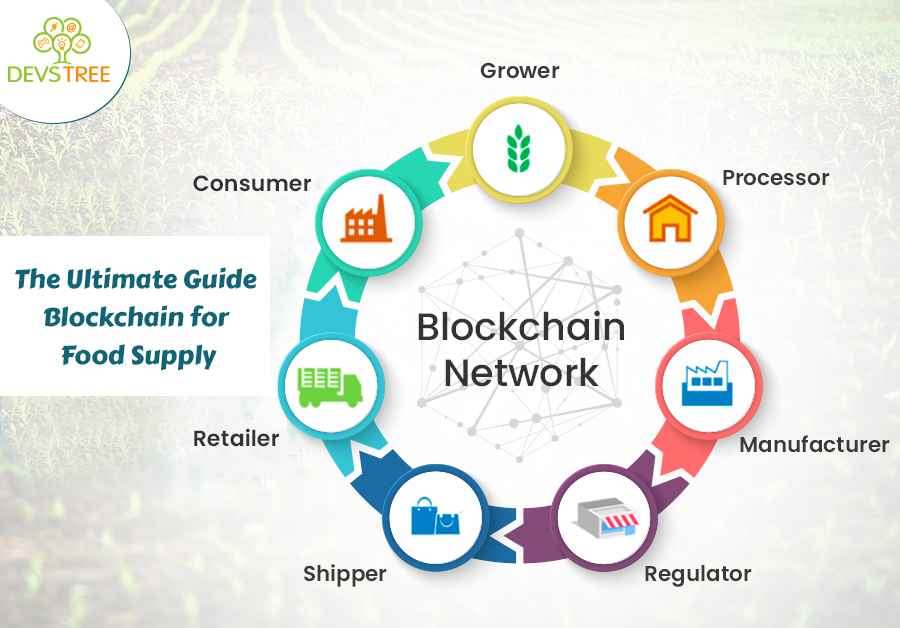People are leaning towards blockchian technology because they have found in it the long sought-after transparency, cost-efficiency, and security efficiency. The maintenance of a decentralized ledger has made it possible. Blockchain technology provides more benefits to the agricultural sector.
Using blockchain technology has become possible to track items from harvesting farms to tables. While improving efficiency and reducing cost, the new technology avoids tampering and contamination. The amount of food lost could be tracked. Proper record keeping is another advantage.
The Solution to a Prolonged Problem!
Application of Blockchain for Food Supply Chain has long since been awaited. Individuals, enterprises, logistics, activities, and information are involved in tandem to supply agricultural products or services from supplier to customer. The inefficiencies noted in the food supply industry, such as malnutrition, food waste, and food malpractices, are properly tackled.
By implementing this system, the food prices have been brought down and stabilized. Moreover, there has been overall efficiency in managing, producing, and supplying food globally.
Food Supply-Chain Flow
- Procurement of Raw materials: Obtain agricultural or animal-based stock from the regional, local, or international markets.
- Processing and Packaging: By producing food in the defined process, package them
- Storing the finished food commodity: keeping in mind the degree of permissibility is vital.
- Distribution of various networks: Wholesale and retail are taken care of.
Challenges of Food Supply Chain
The functioning of the food supply chain is hindered mainly because of its complexities and the number of players involved. The UNDP points out that there is 30% food wastage every year. 1.4 billion Perishable goods go waste to disorganized supply chains.
DEFECT IN THE CURRENT FOOD SUPPLY NETWORK!
1: Transparency and Tracking
Insufficient traceability and lack of accountability with many stakeholders render the food supply network inefficient. All these are logistic mismanagement, labor issues, food tampering, and miscommunication.
2: Lack of Data
Data related to harvesting, production, and consumption are not authentically verifiable. They are thus not reliable. Companies don’t share their data with their counterparts. Different companies control each phase related to the supply chain. Hence there are operational and administrative problems.
3: Loss and Waste of Food
The loss and waste are in astronomical numbers. Statistics from America show that the USA disposes of 40 million tons of food annually. It is estimated by Food and Agriculture Organization (FAO) that about 30 to 40% of food production is wasted or lost at the initial stage.
Other factors responsible for wanton food wastages are over and under-production of food products, supply of sub-standard or same commodities, and lack of proper infrastructure.
4: Imbalance in Distribution & Consumption
America produces 80% of global food requirements but wastes 40% of the produce yearly. This imbalance happens in other third-world countries in the same demography.
There may be an abundance in one region, whereas there may be a food shortage in another. Moreover, political and economic factors contribute significantly to the food supply network.
5: Insecurities in Food & Food-borne Diseases
WHO says that more than 600 million people fall sick, and more than 4,20,000 people die annually due to consuming contaminated food items that could be chemically induced or contaminated otherwise.
The complexities of the supply chain particularly associated with malnutrition impact the overall health of the consumers. The malpractice is undertaken at regional and international levels. However, this remains unchecked.
6: Environmental Impact of Agriculture
Those in the agricultural sector have been deeply concerned about climate change and global warming. Extreme climate change will make them extremely vulnerable, and the worst affected will be the farm sector and the food supply chain network.
For instance, lack of gathering authenticated information about the change in weather. Erratic weather changes lead to less production and the consequent price rise, reduced quality of food, and food shortage.
Blockchain & Food Supply Chain!
As per UNEP, the world population will be 9 million by 2050. This will require an additional 60% increase in global food production. A very simple way will be to minimize the waste and loss that will feed the extra mouths. The challenges narrated above can be sorted by a new technology known as distributed ledger technology.
There will be an assured fluid food process to generate more food with the same efforts and sources. This can be done by introducing blockchain technology into the food supply chain. Transparency and overall efficiency will do the job.
Transparency & Traceability
Companies can track their supply chain more efficiently, and there will be the least chances of misappropriation, wastage, or loss. If you use blockchain technology, you can have a track of food items throughout their journey from production, to grocery store and distribution of the same. While storing in the store information online will be available for the verification of the same.
Proper monitoring will be easier. Moreover, the transparency of blockchain will help to root out the hidden and obvious corruption or other weak points. Accountability will be established to help in up swinging the Internet of Things (IoT). This boosts data sharing
Storage of Factual Data
Data related to the food supply chain are incomplete, fragmented, unauthenticated, and scattered. Therefore making any administrative decision may be either faulty or not possible. But the immutable and shared data can resolve the issues. Data sharing will help each other.
The distributed ledger will have consolidated, relevant, and authenticated data that every stakeholder can share.
Food Safety
Blockchain is viewed by all global players as well as local companies. It helps food safety in the following manner.
- The place and time of growing the food
- Easy access to names of growers
- Ensuring high-quality food
- Consumers could trace back the origin of their food
- Reduction of food fraud, adulterated, sub-standard, or imported food
- Boost quality control
Conclusion!
In the present-day business system of unethical competition, blockchain technology has become the need of the hour. It stops the corrupt practices and sets the loopholes in the existing food supply network.

